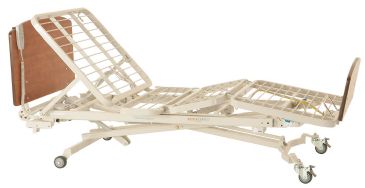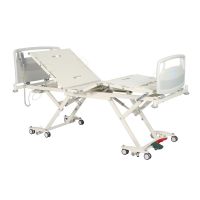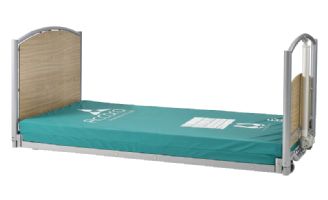 Written by Hulet Smith, OT
Written by Hulet Smith, OT
Falls present a risk of serious injury. Every year, more than 36 million elderly people fall, many of them suffering from falls from bed. About 8 million of these incidents result in injuries that range from minor bruising to broken bones and head injuries. One way to significantly lower the risk of an injury due to a fall from the bed is to make the transition to a low bed. Reducing the distance between the bed and the floor lowers the risk of serious injury in case of a fall. To help you choose the right low bed from the multiple styles that are available, this article explains the differences between a low bed, an ultra-low bed, and a floor bed, with the benefits and drawbacks of each design, and features to be considered when making a purchasing decision. We’ll reveal our picks for the best in each category and answer some common consumer questions.
Low beds are all usually less than a foot from the floor. Beyond that, they are categorized as low, ultra-low, or floor beds. To help you determine which style is the best choice for your situation, this article compares the advantages and disadvantages of each, provides recommendations for the best options in each category, and lists features to consider when purchasing one of these beds.
Although low beds don’t necessarily prevent a fall, by reducing the distance a patient falls after rolling out of bed, the chance of serious injury is also greatly reduced. Additionally, a low bed that allows a user to put their feet flat on the floor while sitting on the edge of the bed is conducive to better leverage and stability while getting in and out of bed. One advantage of a low bed in addressing falls over a standard height bed with bed rails is that people with dementia are at an increased risk for entrapment or serious falls from trying to exit the bed by climbing over the rails.
 | Retractabed-Fixed | Low Retractable Bed by Med-Mizer View Product |
Standard low beds are the most common kind, generally with a minimum height of about 9 ½ inches from the ground with adjustability so they can be easily raised to a standard bed height of about 25 inches. For someone at risk of rolling out of bed, it’s appealing to be able to get into the bed while it’s set at a normal height. The bed can be lowered for safe sleeping, then raised in the morning to comfortably and safely get out of bed. To see our best-selling low beds, check out The 5 Best Low Beds for Fall Prevention. That article guide is a great resource if you are interested in learning more about low beds and features to consider.
 | Acute Care Heavy-Duty Hospital Bed - B333 by CostCare View Product |
An ultra-low bed, with a minimum height of about 7 ½ inches, puts the user a couple of inches closer to the floor than a standard low bed. Although the lower height might be fixed, like most low beds, this design is usually adjustable up to a standard bed height of about 25 inches. Adjustable ultra-low beds come in manual or electric models, and some have optional position adjustments that raise and lower the bed in sections.
 | FloorBed by Accora, Floor Level Fall Prevention, Height-Adjustable, Ultra-Low Bed with Bariatric Option View Product |
For the lowest of the low beds, turn to a bed on the floor, with a minimum height of just around 3 inches. As with other low beds, the mattress sits on a frame that is low to the ground, and floor beds are adjustable to a standard height of about 25 inches. The extremely short distance from the floor makes this style a good tool for injury prevention for anyone at risk of rolling out of bed. Many models come with additional profiling functions of a nursing bed.
Aside from a few inches, there might not seem like there are a lot of differences between low, ultra-low, and floor beds. But there are several factors that figure into choosing which bed is best for your unique situation.
To be safe, a bed has to be built to accommodate the weight of the user. There are bariatric models available with higher weight capacities to comfortably and safely serve larger-framed users, so check the bed’s specifications to ensure it will meet the needs of the sleeper.
Some of these beds are purchased as frame only, while other beds offer compatible mattresses. Your choice of mattress will add to the total cost of the bed. Mattresses also add overall height to the bed, so that could be something to consider if you wish to purchase a very tall mattress. This could hypothetically matter if you also plan to purchase side rails.
Most low beds are adjustable to about 25 inches, which is the height of a standard bed, with allowances made for different mattress heights. A hospital bed is usually around 35 inches high including the mattress. The height range will impact not only how low the bed goes, but the level it can be raised to in order to provide caregiver access, so it’s an important factor in making your buying decision.
Although the most common size of a low bed is a twin or twin XL (similar to a hospital bed size), there are other sizes available to suit more than one sleeper. Again, if shopping for a two-person low bed, checking the weight capacity is important to ensure the bed is built to accommodate more than one sleeper.
Adjustability refers to more than just bed height. If the user needs to have their head elevated for comfort or therapy, or requires the Trendelenburg or Reverse Trendelenburg position, the adjustability of the bed frame needs to be considered. Not every bed frame is created equal, so be sure the frame you get provides the level of adjustability you need. To learn more about this position, read our article What is the Trendelenburg Position Used For?
Just as every person is unique, what creates the safest and most comfortable environment for them is also unique. Grab assist bars, appropriately fitted bed linens, floor mats, bolsters, and cushions that fit against the sides of the bed to help improve safety and reduce falls are all options to enhance the user experience and increase safety.
A: Low bed frames are about 9 ½ inches off the floor and ultra-low bed frames are about 7 ½ inches from the floor.
A: A floor bed sits so low to the ground that the bed frame is only about 3 inches from the floor.
A: When a user is prone to or at risk of rolling out of bed.
A: Because residents are often elderly people who are susceptible to cognitive decline that can lead to trying to leave the bed at night. If bed rails are used to keep a user in bed, the resident could get entrapped while trying to climb out of bed or injured getting over a high bed rail. Low beds reduce the risk of injury if a user is going to try to leave the bed at night.
A: When users get into and out of bed, it should be at a height where the user can put their feet flat on the ground while seated on the bed to allow maximum leverage and stability. This is probably in the 25-30 inch range. If an elderly person is prone to falling out of bed at night, a low bed that lowers to mere inches off the ground provides the best height for sleeping.
A: They are good for people who are at risk of falling out of bed, which can cause serious injury if the fall is from a height of two to three feet off the ground, versus the much shorter distance to the floor with a low bed.
A: Medicare Part B covers hospital beds as durable medical equipment (DME) that your doctor prescribes for use in your home. This can include low hospital beds. If your supplier accepts assignment you pay 20 percent of the Medicare-approved amount, and the Part B deductible applies. Medicare pays for different kinds of equipment in different ways. Medicare will only cover your DME if your doctors and DME suppliers are enrolled in Medicare. Rehabmart also offers Affirm financing to qualifying customers.
By reducing the distance between the bed and the floor, a low bed could be the answer to lowering the risk of a serious injury due to a fall from the bed. With the multiple styles and options available, it really comes down to reviewing all the options and how they match up with your needs.
Our selection of low beds provides the best deals on the highest quality equipment to ensure the safety and comfort of the user.
We appreciate your time reading this article, and invite you to visit Caregiver University for more informative buying guides and caregiver resources.

Co-founder/CEO of Rehabmart, Pediatric Occupational Therapist, husband, and father. Passionate about connecting special needs kids with superb nutrition, sensory integration, and complementary health strategies. Excited about Rehabmart's mission to become the premier online educational platform which empowers caregivers by spotlighting innovative devices and interventions to achieve optimal patient response and recovery.